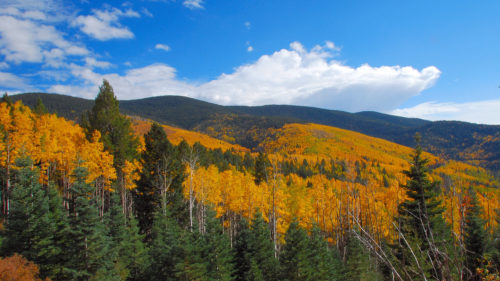By BEN NEARY
NMWF Conservation Director
If a person spends enough time outdoors in New Mexico, sooner or later they’re going to encounter a bear. At that moment, Daryl Ratajczak’s tips on understanding bear behavior could prove essential.
Ratajczak, a wildlife biologist with the U.S. Forest Service in New Mexico, has studied bear behavior extensively.
By reading bears’ movements, their sounds and their expressions, Ratajczak says he can tell whether they’re looking to escape from an encounter with a human — which is their typical reaction — or possibly if they’re sizing up a person to provide their next meal.
Ratajczak will present a talk titled “The Language of Bears” at an event organized by the New Mexico Wildlife Federation. The free lecture is from 5:30-7:30 p.m., Wed., June 12, at Marble Brewery’s Northeast Heights location, 9904 Montgomery Blvd., NE, in Albuquerque.
Ratajczak said his presentation is tailored to, “any outdoors person that is concerned, or wants to know more about what to do should you run into a bear. And the cool thing with New Mexico, that’s pretty much everybody because we live in bear country.”
The talk will start with basic biology so people understand what makes a bear tick and why they do what they do, Ratajczak said.
“Then, I go into the actual vocalizations and body posturing that bears will exhibit whenever there’s a close encounter,” Ratajczak said.
“Once you understand what’s going on in a bear’s mind — and they’re very, very routine with their vocalizations — they will give you cues as to what mood they’re in,” Ratajczak said. “Once you know that, and you can read that and be comfortable with that, you have much more confidence if you do encounter a bear out on the trail or wherever.”
He said he will present slides and videos that show each element of bear behavior that he mentions in the talk.
“I’ll be talking about bear biology, bear behavior and trying to have a better understanding of what a bear’s trying to tell you whenever you run into one,” Ratajczak said.
Ratajczak is former manager of the Appalachian Bear Center, located in Tennessee near Great Smoky Mountain National Park. At the center, he did black bear education and research and rehabilitated orphaned cubs brought to him by the National Park Service and the Tennessee Wildlife Resources Agency, the state wildlife agency.
After leaving the bear center, Ratajczak worked for the Tennessee Wildlife Resources Agency as big game coordinator. He oversaw state programs on bears as well as on whitetail deer, wild hogs and elk.
Ratajczak then served as chief of wildlife for the Tennessee state agency. While he said he loved the job, he said he left because he always had wanted to work in the West.
Ratajczak joined the U.S. Forest Service a few years ago and came to New Mexico. He said he appreciates the state’s amazing wildlife.
New Mexico has only black bears and no grizzlies. And Ratajczak said the black bears here generally only pose a minimal risk to people.
“Most of the encounters you have with bears, the bears just want to get away from you. And he’ll give you a cue that he wants to get away from you,” Ratajczak said.
“Every once in a while, it doesn’t happen too often, but there are moments when black bears go on the offensive because they’re trying to seek a food reward,” Ratajczak said. “And your reaction in that case is usually much different than if you encounter a mother with cubs. And so, knowing how to differentiate between the offensive and defensive situation when you have a bear encounter is critical.”
In the typical interaction with bears in New Mexico Ratajczak said, “You’re not really in too much danger as long as you respect the bear and get out of his way. But if he’s coming towards you to see if he can get some food out of you, then you have to be able to recognize that pretty quickly, because not every bear encounter is the same.”
In addition, people who are camping must realize the importance of controlling things that can attract bears, Ratajczak said. “Most people think about things that they’re cooking, but then they’ll crawl into a tent with ChapStick and blueberry toothpaste. You’ve got to think of everything,” he said.
Bear populations are increasing nationwide, Ratajczak said. Most of the increase is the result of bears repopulating areas in the East where they had been nearly wiped out, he said.
“As far as our western states, we’ve always had bears and we’ve managed them very well,” he said, adding that populations in the West are staying relatively static.
Bears in the West show more color variation than their eastern cousins, Ratajczak said. He said in the East, they’re all black with an occasional white patch on the chest. In the West, however, he said their colors range from black to red to blond and every combination in between.
In many areas of the West, there’s an average of one bear for every two square miles of forest land, Ratajczak said. He said the numbers are higher in denser forests in the South and East, but said the bears are harder to spot because of the much thicker vegetation.
Ratajczak said hikers commonly ask him whether he recommends bear spray or firearms for bear encounters.
“There’s one piece of equipment that everyone always overlooks and they immediately go to bear spray or firearms,” he said. “And what I stress is the most important and the most effective tool that you have, and you always have it on you, is your brain.”
Ratajczak said a person’s situational awareness is always the most effective tool they can carry.
“After that, I always lean toward the bear spray, and I’ll tell you why. With a firearm, you can miss,” Ratajczak said. He said he would recommend that a person be able to put up a wall of defense in the form of pepper spray in a stressful situation rather than count on hitting a bear with a single projectile from a gun.
“I live in Rio Rancho, and they occasionally pull a black bear out of Rio Rancho,” Ratajczak said. “The thing about New Mexico is you’re not likely to run into a bear, but there’s always a chance.”



